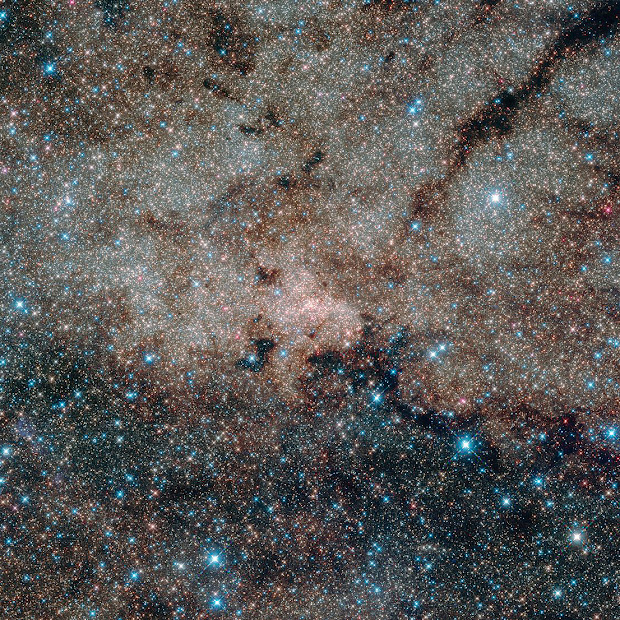Click on the image for higher resolution (9.5 MB)
This infrared image from the Hubble Space Telescope shows the center of the Milky Way, 27 000 light-years away from Earth. Using the infrared capabilities of Hubble, astronomers were able to peer through the dust which normally obscures the view of this interesting region. At the center of this nuclear star cluster – and also in the center of this image – the Milky Way's supermassive black hole is located. The center of our galaxy in the constellation of Sagittarius, is a crowded place. This region is so tightly packed that it is equivalent to having one million stars crammed into the volume of space between us and Alpha Centauri, located 4.3 light-years away. At the very hub of our galaxy, this dense nuclear star cluster surrounds the Milky Way’s central supermassive black hole, known as Sagittarius A*, which alone is about four million times the mass of the Sun. Sagittarius A* is not the only mystery lurking in this part of the galaxy. The crowded center contains numerous objects that are hidden at visible wavelengths by thick clouds of dust in the galaxy's disc. In order to truly understand the central part of our galaxy astronomers used the infrared vision of Hubble to peer through this obscuring dust. To reveal the image in all its glory the scientists then assigned visible colours to the different wavelengths of infrared light, which is invisible to human eyes.
The blue stars in the image are foreground stars, which are closer to Earth than the nuclear star cluster, whilst the red stars are either behind much more intervening dust, or are embedded in dust themselves. Some extremely dense clouds of gas and dust are seen in silhouette, appearing dark against the bright background stars. These clouds are so thick that even Hubble's infrared capability cannot penetrate them. In addition to the stars hidden by the dust astronomers estimate that there are about 10 million stars in the cluster which are too faint to see, even for Hubble. Using Hubble's vantage point above the atmosphere and its high resolution, astronomers were able not only to reveal the stars in this cluster but also to measure their movements over a period of four years. Using this information, they inferred important properties of the nuclear star cluster, such as its mass and structure. The motion of the stars may also offer astronomers a glimpse into how the nuclear star cluster was formed – whether it was built up over time from globular star clusters that happened to fall into the center of the galaxy, or from gas spiralling in from the Milky Way’s disc to form stars at the core.
Image Credit: NASA, ESA, and the Hubble Heritage Team (STScI/AURA)
Acknowledgment: NASA, ESA, T. Do and A. Ghez (UCLA), and V. Bajaj (STScI)










1 comment(s):
We humans are focused on the North Star because it helps us navigate and provides orientation, which oddly means to face east, but it is toward the center of our galaxy that we should be orientating, as it is where the Milky Way is centered and gravitating. Looking north means we are earth focused. Looking toward the galactic center in the constellation Sagittarius means we are more universally focused. Let's figure out the center of the universe later. Let's work on the center of the galaxy next.
Post a Comment